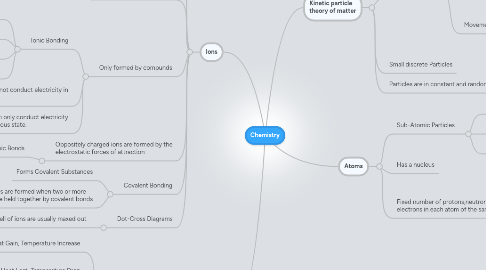
1. Transfer of energy and Change In State
1.1. Heat Gain, Temperature Increase
1.1.1. Kinetic energy increases, forces of attraction decreases
1.1.1.1. Solid=>Liquid
1.1.1.1.1. Melting
1.2. Heat Lost, Temperature Drop
1.2.1. Kinetic energy decreases, forces of attraction increases
1.2.1.1. Liquid=>Solid
1.2.1.1.1. Freezing
1.3. Heat Gain, Tempaerature Increase
1.3.1. Kinetic enery increases,forces of attraction decreases
1.3.1.1. Liquid=>Gas
1.3.1.1.1. Evaporation&Boiling
1.4. Heat Lost, Temperature Drop
1.4.1. Kinetic energy decreases, forces of attraction increases
1.4.1.1. Gas=>Liquid
1.4.1.1.1. Condensation
1.5. Heat Gain, Temperature Increase
1.5.1. Kinetic energy increases, forces of attraction decreases
1.5.1.1. Solid=>Gas
1.5.1.1.1. Sublimation
1.6. Heat Lost, Temperature Drop
1.6.1. Kinetic energy decreases, forces of attraction increase
1.6.1.1. Gas=>Solid
1.6.1.1.1. Deposition
2. Ions
2.1. Have charges
2.1.1. Postive Ions
2.1.1.1. More protons than electrons
2.1.2. Negative Ions
2.1.2.1. More electrons than protons
2.2. There are no ions of noble gases
2.2.1. Inert
2.2.2. No chemical reactions
2.2.3. Stable electronic configuration
2.3. Does not occur for elements
2.4. Only formed by compunds
2.4.1. Ionic Bonding
2.4.1.1. Metals
2.4.1.1.1. Tends to lose electrons
2.4.1.2. Non-Metals
2.4.1.2.1. Tends to gain electrons
2.4.1.3. Semi-Metal
2.4.1.3.1. Graphite
2.4.1.4. Transfer of electrons
2.4.2. Ionic Compunds cannot conduct electricity in the solid state.
2.4.3. Ionic Compounds can only conduct electricity in the molten or aqueous state.
2.5. Oppositely charged ions are formed by the electrostatic forces of attraction
2.5.1. Forms Ionic Bonds
2.6. Covalent Bonding
2.6.1. Forms Covalent Substances
2.6.2. Molecules are formed when two or more atoms are held together by covalent bonds
2.7. Dot-Cross Diagrams
2.7.1. Valiant shell of ions are usually maxed out
3. Kinetic particle theory of matter
3.1. Model of matter
3.1.1. Arrangement
3.1.1.1. Gas
3.1.1.1.1. Held very far apart by weak forces of attraction
3.1.1.2. Liquid
3.1.1.2.1. Held close together by strong forces of attraction
3.1.1.3. Solid
3.1.1.3.1. Held very closely together in fixed positions by very strong forces of attaction.
3.1.2. Movement
3.1.2.1. Gas
3.1.2.1.1. Moves freely in all directions at great speed
3.1.2.2. Liquid
3.1.2.2.1. Slides over one another
3.1.2.3. Solid
3.1.2.3.1. Vibrates in a fixed postion
3.2. Small discrete Particles
3.3. Particles are in constant and random motion
4. Atoms
4.1. Sub-Atomic Particles
4.1.1. Protons
4.1.2. Neutrons
4.1.3. Electrons
4.1.3.1. Mass of 1/1998g
4.2. Has a nucleus
4.3. Fixed number of protons,neutrons and electrons in each atom of the same element.
4.3.1. Electronically Neutral Entity
4.3.1.1. Neither Positively or Negatively charged
4.3.2. Isotopes are formed when atoms of the same elements do not have the same number of neutrons.
